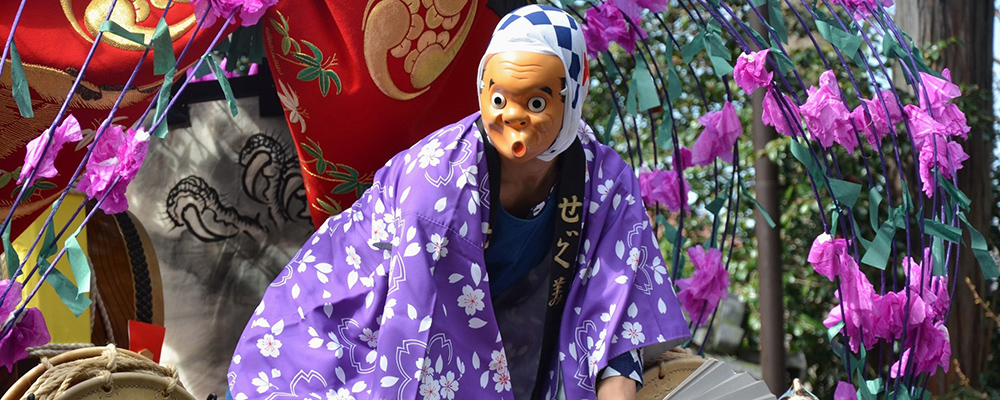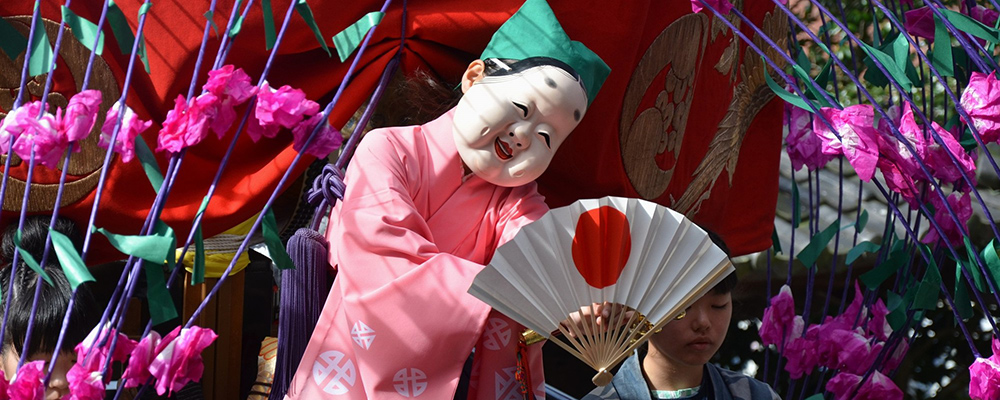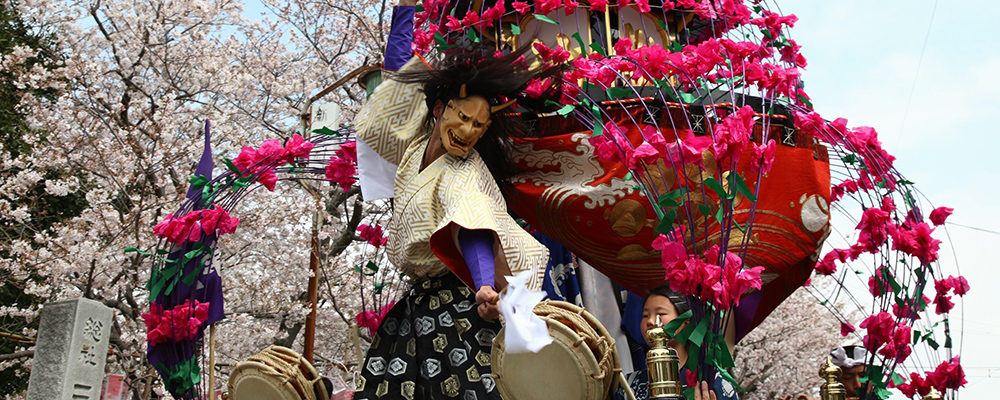Spring Mikumano Shrine Festival
When cherry trees in the grounds of Mikumano Shrine are at their best, thirteen festival floats parade in Yokosuka. There are thirteen community blocks in Yokosuka. A community block is called Machi in Yokosuka. Each community block has its own festival floats and the name of community block is abbreviated into one letter. Festival participants wear happi, traditional Japanese workman’s coats, bearing the letter that stands for the name of community block. Almost all people in each community block take pride in their festival float, saying, “Our festival float is the best in Yokosuka.” During the festival, Yokosuka is animated by festival music. Festival participants haul their own festival float to the festival music, Sansyabayashi, and shouting, “Shita. Shita”. The atmosphere of the festival is very pleasant. Spring Mikumano Shrine Festival is scheduled for the first weekend of April.
First Day
The first day of the festival is the Eve of the festival. On the evening of the first day, festival participants haul their festival floats in their own community block and two adjacent community blocks, declaring that the festival starts. They haul their festival float from 3 p.m. to 9 p.m. on the first day.
Second Day
On the morning of the second day, the delegates of each community block gather at Mikumano Shrine to draw the lots. On the third day, their festival floats follow the processions of Mikoshi, portable shrine, in a line and parade through Yokosuka. The delegates decide the order of the line by lottery. Then, thirteen festival floats gather at Mikumano Shrine at 9 a.m. One community block out of thirteen blocks performs the festival music, Sansyasaireibayashi, on the stage in Mikumano Shrine at ten thirty. They express gratitude that they can hold the festival in the presence of the deities. One community block is responsible for performing the festival music each year. : They take turns performing the music year after year. Each community block takes charge every thirteen years. After the ceremony, thirteen festival floats leave Mikumano Shrine. They parade through Yokosuka. In every community block, there are special places where festival floats stop to perform the festival music, Syoten, Kamakura and Hityityoume. You can listen to their festival music there. Many festival participants get excited when their festival floats pass each other. Their parade continues until 9 p.m.
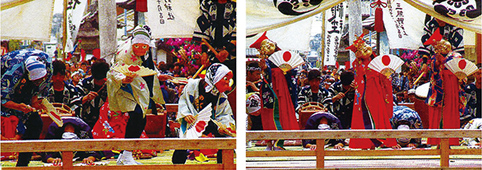
Male clown, Hyotoko (Left) and female clown, Okame (Right) perform on the stage. They practice hard before the performance.
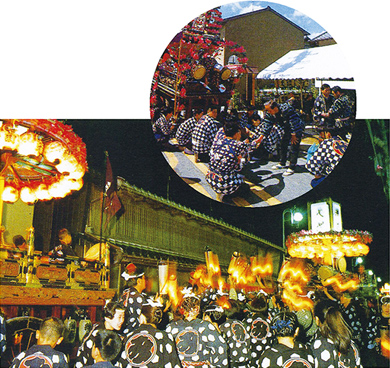
Above; Festival participants perform the festival music in front of Kaisyo (special place). There are thirteen Kaisyo in Yokosuka. They perform thirteen times in total during the festival. Festival music, Shoten, Kamakura and Hityityoume are performed there.
Below; Festival participants get excited, shaking paper lanterns. The doll on the festival floats is removed, and flowers are fixed above paper lanterns, on the evening of the second day.
Festival Map(Friday, Saturday) download here!
Movie
-
Performance on the stage (Full version)(14:52)
-
Performance on the stage (Short version)(3:30)
Third Day
On the morning of the third day, the deity of Mikumano Shrine is invited to the portable shrine called Mikoshi. This ceremony is conducted at 10 a.m. in the shrine’s grounds then, Mikoshi leaves the shrine. About two hundred people join the Mikoshi parade, including men carrying Mikoshi on their shoulders, drum players, the deities and the priests. They wear traditional Japanese clothes. Someone disguises as the deity, Sarutahiko, wearing the special mask. Women who wish easy-childbirth can join the parade with their husband. (The participation fee is 10,000 yen.) When the portable shrine passes, festival participants pay homage to it, sitting on the ground: They must be respectable, even if they are drunk!
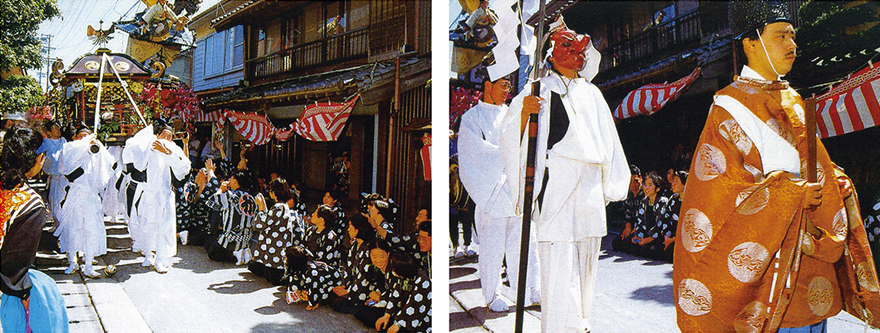
Left; Men wearing white clothes are carrying the portable shrine, Mikoshi, on their shoulders. Festival participants pay homage to Mikoshi, sitting on the ground, while it passes.
Right; The priest leads the Mikoshi parade. A man behind the priest disguises as the deity, Sarutahiko. He wears a special mask with a long nose.
Besides Mikumano Shrine, there are two places where the important ceremony is held, when the portable shrine arrives: A riverbank of Nishi Oya River and Suijingu Shrine. It is said that the deities of Kumano Shrine came to Yokosuka by sea and their boat got to the riverbank of Nishi Oya River, where the ceremony is held during the festival. While the ceremony is conducted on the riverside, the thirteen festival floats wait in Kawaramachi, in the eastern part of Yokosuka.
After they finish the ceremony, the portable shrine leaves the riverbank and the thirteen festival floats follow in a line, parading around Yokosuka, heading for the western part of the town. Although the portable shrine goes to Suijingu Shrine, the floats parade around the streets in the western part of the town.
In Suijingu Shrine, a large picture of Yokosuka Castle is put up and they conduct the ceremony. It is said that the portable shrine entered Yokosuka Castle in the Edo period (1603~1867).
After they finish the ceremony in Suijingu Shrine, the portable shrine returns to Mikumano Shrine at around 2 p.m. Then, they conduct other important ceremonies: Jikatamesai and Taasobi, at Mikumano Shrine.
Besides the parade, there are three important ceremonies conducted on the third day. They are Kosazukenoshinji, Jikatamenomai and Taasobi.
Kosazukenoshinji is a ceremony to pray for easy-childbirth. A sacred doll, Nennekosama, is worshiped by the women who want a baby. It is said that women are guaranteed easy-childbirth, if they hug Nennekosama during the festival. This ceremony is held at Mikumano Shrine at 7 a.m., on the riverbank of Nishi Oya River at 11 a.m. and at Suijingu Shrine at 1 p.m. respectively. Women who join the parade usually hug Nennekosama at each place.
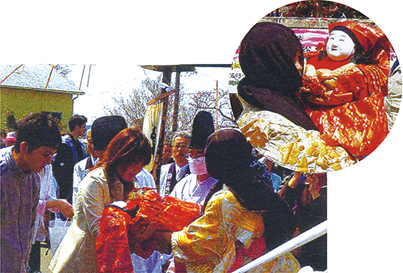
Women hug the sacred doll, Nennekosama, praying for easy-delivery. Some women visit Yokosuka to hug Nennekosama from distant towns. It is said that many women do have a baby, after they have hugged Nennekosama.
Jikatamenomai is a ceremony to ward off devils hiding under the ground and to purify the ground. Seven protagonists and twelve supporting players perform on the stage. This ceremony consists of seven performances. They wear traditional Japanese clothes and protagonists perform with a Japanese sword or bow in their hands.
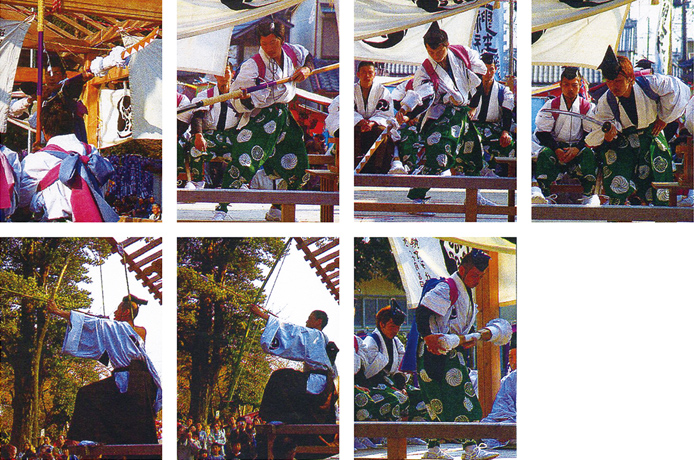
Here are the seven performances of Jikatamenomai.
After Jikatamenomai is finished, they conduct Taasobi. Taasobi is a ceremony to pray for a good harvest of rice. Several young men imitate planting rice, while singing a rice-planting song. They use pine needles as rice seedlings.
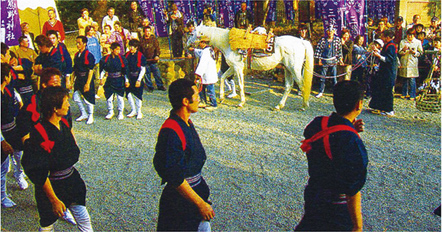
When the floats return to Mikumano Shrine at around 9 p.m., the climax of the festival, Sensyuraku, begins. Sensyuraku means “the last and most important” in Japanese language. It is the most exciting ceremony in the festival. With the clapping of hands, the festival music starts. Being beside themselves, festival participants dance to the music emotionally, shaking their festival floats right and left. On the floats, devil clown, Hannya dances violently to the festival music, Bakabayashi. You’ll be overwhelmed by the atmosphere! Spectators, as well as festival participants, get very excited in the final ceremony.
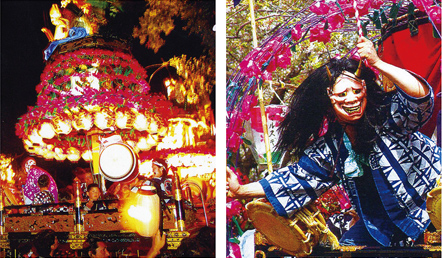
Left; Sensyuraku. Thirteen festival floats, decorated with flowers and lanterns, gather in the precincts of Mikumano Shrine. You’ll regret, if you miss the chance to watch the amazing climax of the festival.
Right; Devil clown, Hannya, dances violently on the festival float. When the festival reaches its climax, the Bakabayashi, festival music, is performed and Hannya dances. It is said that a female god went mad, when her baby was kidnapped, and she became Hannya.
Festival Map(Sunday) download here!
Movie
-
Processions of Mikoshi(4:02)
-
In front of Mikumano Shrine(3:36)
-
Traditional ceremonies(5:38)
-
Climax of the festival(5:30)
Festival Music
"Sansyasaireibayashi"
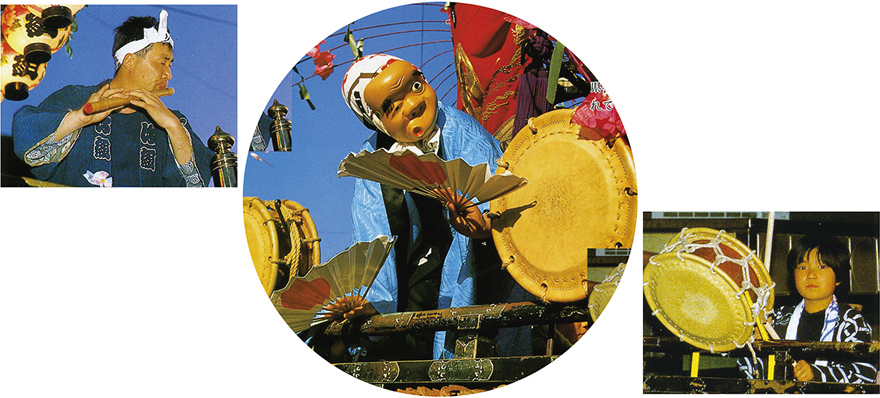
Musical instruments are two small drums, one large drum, one gong and two flutes.
This festival music, which is played on the festival float, was designated as the first intangible cultural asset by Shizuoka Prefecture in 1955, having been valued by its long history and characteristic tune.
“Sansyasaireibayashi” is a type of festival music. In mid 18th century when Tadanao Nishio, a lord of Yokosuka clan, stayed at Edo to meet Tokugawa Shogun (military leader), his retainers learned the festival music which was popular in Edo at that time. They brought the music back to Yokosuka and arranged it with the characteristic tune, so beginning the tradition of “Sansyasaireibayashi”.
A male clown called “Hyotoko” and a female clown called “Okame” dance to the music. They wear special masks. This music consists of three main tunes and three supplemental tunes. The former includes “Ouma”, “Yataishita” and “Bakabayashi”. The latter includes “Syoten”, “Kamakura” and “Hityityoume”. “Ouma” is played in most parts of the festival. “Yataishita” is a tune in quick tempo. When festival participants haul their festival float quickly, “Yataishita” is played. “Bakabayashi” is a passionate tune. When the festival reaches its climax, “Bakabayashi” is played. Festival participants dance violently to the tune, shaking their festival float right and left. A devil clown called “Hannya” dances to the music violently. It is said that a female god went mad, when her baby was kidnapped, and she became “Hannya”. Three supplemental tunes, “Syoten”, “Kamakura” and “Hityityoume” are played at certain spot called “Kaisho” to show their performance to the spectators.
Festival Float
structure of festival float
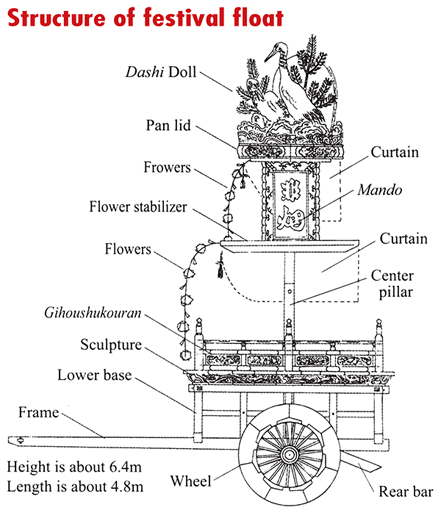
A festival float is called “Neri” in Yokosuka. This festival float is characterized by a center pillar and a large rectangular lantern called “Mando”. The pillar is called “Shingenbou”, meaning God pillar. It is said that the God comes down to the festival float from the heaven through the pillar. A flower stabilizer, “Mando”, and a “pan lid” are fixed on the pillar. A doll called “Dashi” is put on the lid. Each festival float has its own “Dashi”. Some “Dashi” usually stands for a celebrity in history. Other “Dashi” stands for a famous scene in Kabuki. Some “Dashi” are so realistic that you feel that they are alive. The “Dashi”, the curtain called “Tenmaku” and the sculpture are as valuable as works of art. The “Mando” is used as a lamp. Long ago when they didn’t have any generators, a candle was put in the “Mando”. “Dashi” is regarded as a God of the festival float and “Mando” as a throne.
